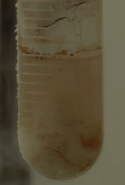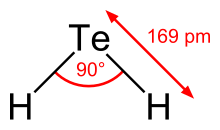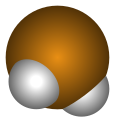
Back Waterstoftelluried Afrikaans هیدروژن تلورید AZB Tellan Czech Tellurwasserstoff German Υδροτελλούριο Greek Ácido telurhídrico Spanish هیدروژن تلورید Persian Telluurivety Finnish Tellurure d'hydrogène French हाइड्रोजन टेल्यूराइड Hindi
 Liquid hydrogen telluride in a test tube
| |

| |
 Tellurium, Te Hydrogen, H | |
| Names | |
|---|---|
| IUPAC name
hydrogen telluride
| |
| Other names
hydrotelluric acid
tellane tellurium hydride dihydrogen telluride tellurane | |
| Identifiers | |
3D model (JSmol)
|
|
| ChEBI | |
| ChemSpider | |
| ECHA InfoCard | 100.029.073 |
| EC Number |
|
PubChem CID
|
|
| UNII | |
CompTox Dashboard (EPA)
|
|
| |
| |
| Properties | |
| H2Te | |
| Molar mass | 129.6158 g mol−1 |
| Appearance | colourless gas |
| Odor | Pungent, resembles rotting garlic or leeks |
| Density | 3.310 g/L, gas 2.57 g/cm3 (−20 °C, liquid) |
| Melting point | −49 °C (−56 °F; 224 K)[1] |
| Boiling point | −2.2 °C (28.0 °F; 270.9 K) (unstable above −2 °C) |
| 0.70 g/100 mL | |
| Acidity (pKa) | 2.6 |
| Conjugate acid | Telluronium |
| Conjugate base | Telluride |
| Structure | |
| bent | |
| Thermochemistry | |
Std enthalpy of
formation (ΔfH⦵298) |
0.7684 kJ/g |
| Hazards | |
| Occupational safety and health (OHS/OSH): | |
Main hazards
|
toxic |
| NFPA 704 (fire diamond) | |
| Related compounds | |
Other anions
|
H2O H2S H2Se H2Po |
Other cations
|
Na2Te Ag2Te K2Te Rb2Te Cs2Te |
Related compounds
|
telluric acid tellurous acid stibine |
Except where otherwise noted, data are given for materials in their standard state (at 25 °C [77 °F], 100 kPa).
| |
Hydrogen telluride is the inorganic compound with the formula H2Te. A hydrogen chalcogenide and the simplest hydride of tellurium, it is a colorless gas. Although unstable in ambient air, the gas can exist long enough to be readily detected by the odour of rotting garlic at extremely low concentrations; or by the revolting odour of rotting leeks at somewhat higher concentrations. Most compounds with Te–H bonds (tellurols) are unstable with respect to loss of H2. H2Te is chemically and structurally similar to hydrogen selenide, both are acidic. The H–Te–H angle is about 90°. Volatile tellurium compounds often have unpleasant odours, reminiscent of decayed leeks or garlic.[2]
- ^ Lide, David R., ed. (2006). CRC Handbook of Chemistry and Physics (87th ed.). Boca Raton, FL: CRC Press. ISBN 0-8493-0487-3.
- ^ Greenwood, N. N.; & Earnshaw, A. (1997). Chemistry of the Elements (2nd Edn.), Oxford:Butterworth-Heinemann. ISBN 0-7506-3365-4.
© MMXXIII Rich X Search. We shall prevail. All rights reserved. Rich X Search
